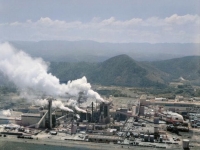Norske Skog Leaves Toxic Mess Behind at Tasman Paper and Pulp Mill in New Zealand

Tasman mill in 1976. Whites Aviation Collection, Alexander Turnbull Library
Traditional Māori owners are fighting to force Norske Skog to clean up the toxic mess left behind by the six decade old Tasman paper and pulp mill on the Rotorua lake on the North Island of New Zealand that closed for good in 2021.
In the 1950s, Lake Rotoitipaku, a traditional lake of the Ngāti Tūwharetoa ki Kawerau peoples, was turned into a dumpsite and filled with over 600,000 cubic meters of industrial waste such as dioxins and polychlorinated biphenyls from the mill's operations. The company also dumped barrels of sodium dichromate and zinc hydrosulphite. Water testing has revealed levels of arsenic and other toxics well above maximum concentration limits for drinking water.
"The poisons, the rubbish from the mill came in one end, and the fish were trying to escape out the other end," landowner Wynyard Hunia told Stuff, a New Zealand website. “They emptied the lake of all the life that was in it, and it was a heartbreaking time. But we understood that it would be restored one day. That's what we thought.”
Over a century ago, settlers - mostly prison labor - began to plant fast growing pine trees on the Kaingaroa Plains in the Bay of Plenty. By the 1920s, this had been turned into a commercial wood plantation named Kaingaroa Forest - and in the 1950s, the Tasman Pulp and Paper Ltd company was established by James Fletcher, a local industrialist.
At the time, Lake Rotoitipaku was used by the local people as a burial ground and sacred site. They fished for eels and trout and hunted wild pigs, and played in the local hot springs, but the government signed an agreement allowing the Tasman Pulp and Paper to dump waste from the mill into the lake.
Fletcher sold the mechanical pulp mill and newsprint mill operations to Norske Skogindustrier ASA (which translates to Norwegian Forest Industries) in the year 2000. (Other mills belonging to the Tasman Pulp and Paper Ltd were bought by Oji Fibre Solutions).
Norske Skogindustrier (since renamed Norske Skog) has been in the business of making newsprint and magazine paper ever since it was founded in Skogn, Norway, in 1962, but over the last decade, the collapse of the publishing industry has forced the company to close mills and declare bankruptcy.
“The structural change in the newsprint industry provided no viable alternative for paper production at Tasman,” said Eric Luck, Norske Skog's regional president, when he announced the closure in 2021. “The domestic market for newsprint has shrunk considerably and so too have export markets. Covid-19 has hastened the decline.”
When the company shut the mill down, it essentially refused to clean up the mess left behind by Tasman paper and pulp mill, by taking advantage of loopholes in the laws and well as in the leasing agreement that they signed for the land. Government regulators were furious. “Our patience has run out with companies, some multinational, who have been within the letter of the law, but morally, in their obligations to the community and the environment, have been less than satisfactory,” Allan Freeth, chief executive of the Environmental Protection Authority, told Stuff.
Local activists say that the company should have produced an environmental report after the mill closed.
"The whole Tasman site is totally contaminated. It's been running for 66 years, polluting our river and polluting our people,” Tipene Marr, a member of the Ngāti Rangitih nation, told Stuff. "We should get online with the Norwegians and tell them they're leaving a whole lot of pollution in New Zealand. I bet they don't do it in Norway."
But the company says it will do no more than it is required to. "The environmental issues across the site are well known and are being managed in accordance with existing licence conditions," said Norske Skog in a statement to Radio New Zealand.



